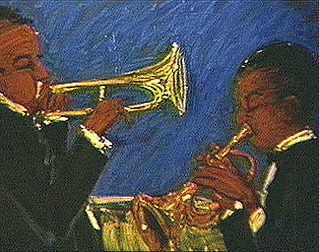Art Culture and Technology (ACT) is attempting to bring animation to this year's Atlanta Olympics as part of an innovative multimedia installation. Mark Segall reports.

Animation and the Olympics aren't two things you automatically associate. But back in 1984, during the Los Angeles games, the Olympic Arts Festival sponsored a fourday Olympiad of Animationfeaturing screenings of a selection of the best animated films of all time and films especially made for the event thatwere shown at the Academy of Motion Picture Arts & Sciences in Beverly Hills. And this past March, animators all over the US opened their ASIFA newsletters to find the following call for entries:
"Art Culture and Technology (ACT) is seeking animated works by independent filmmakers, to be shown as part of a huge multimedia installation to run throughout the Olympics (July 19 to August 4)."
The ads mentioned a $250 honoraria for each work that was accepted, and a modest $10 entry fee. Entry requirements weren't strict: any film fitting one of two broad themes-Bodies in Motion and Building Communities-could be entered; films could be old or new, and filmmakers could send one entry or several. The shows' tentative location (the Underground Atlanta Mega-Mall) was likely to see a lot of Olympic foot traffic. While 84's Olympiad had the cachet of an official connection to the Olympics, ACT offered animators something just as important--the chance to be part of permanent installations in Atlanta and New York long after the games were over.
Like it's parent organization, the Friendship Ambassadors Foundation, ACT is devoted to cultural exchange between countries. It's FAF's hightech branch: where crafts, folklore and humanities meet the new media. Promoting independent animation has been part of ACT's mission from the start. During 1995's Fourth World Women's conference, ACT showed a program on Beijing Train Station's 120square meter Jumbotron screen: film and video by women artists, including animators Faith Hubley and Joanna Priestley.
An Overarching Concern
For the Atlanta event, besides running ads and announcements, ACT mailed out 600 or 700 entry forms. Response from the animation community was enthusiastic. Submissions came to producer Iva Kaufman's Manhattan office from all over the US and Canada and as far away as France. Iva, curator Somi Roy and assistant curator Amy Morley viewed over 50 videotapes, and finally chose around 20 for the installation. An overarching concern was to choose films suitable to an international, multilingual audience--films that0- do not rely on dialogue or narration to get their point across. Beyond that, different pieces were chosen for different reasons. Some fit well into a videowall or multimedia setup--what you might call ambient animation--abstract loops of color and sound. Some covered social issues--smoking, violence, ecological destruction, the rights of women and children. Emily Hubley contributed Enough, a grant-you-three-wishes fable about greed. Others were picked because they typified a particular culture or place--Sharon Shimazu's Mr. Right, Debra Callabresi's Quilted by Hand. Films aimed at children were highlighted along with films by animators age 15 or younger. The most energetically animated pieces, such as Karen Aqua's stunningly choreographed Perpetual Motion and Kakania, fit the Bodies in Motion theme. Some do not fit any of the themes perfectly, but were picked just because they made Iva and Amy laugh--John R. Dilworth's Dirdy Birdy, John Schnall's Buy My Film, Nancy Keegan's Sophie.
 Smoking on the Hush, Hush Tip by John Serpentelli. Courtesy of ACT.
Smoking on the Hush, Hush Tip by John Serpentelli. Courtesy of ACT.  Kakania by Karen Aqua. Courtesy of ACT.
Kakania by Karen Aqua. Courtesy of ACT.
The animations will be part of a multimedia installation along with documentaries, experimental films, and video and multimedia works. After the Mall management changed its mind about having the show, Ms. Kaufman lined up a new venue: the 3,000 square foot library at the Atlanta College of Art's Woodruff Arts Center. The move from the Mall may lose ACT a few sports fans, but puts the installation closer to a museum, a symphony hall and many Olympicsrelated arts and cultural events. Engineered and designed by ACT's Howard Weiner and David Miller, the installation has the sponsorship of Shaw Ross Importers & Distributors (fine wine & spirits) of Miami, Florida.
The Olympic selections will also be part of ACT's most ambitious postOlympics project: supplying the content for soontobeinstalled StreetSmart kiosks in NYC. Twenty-five percent of ACT's contribution will be animation, the other 75% a mix of videos, documentaries and other artsrelated material. The first five kiosks will be at City Hall and the Queens, Brooklyn, Bronx and Staten Island borough halls. Ultimately there will be 50 throughout town, their material tailored to different cultures and available in several languages. People will be able to mail order the animations they see from the kiosks. ACT will also raise revenues for future projects by selling kiosk advertising. The idea, says Iva Kaufmann, is to create a new revenue stream for arts funding --to funnel forprofit money into nonprofit projects. If successful, the kiosks will be displayed in other cities. The animations will also appear at Studio 64, a spacious artsoriented meeting place scheduled to open in New York's Chelsea district in August.
StreetSmart
Nationally, ACT has lined up postOlympics sites for the Atlanta reel in Chicago, Washington, D.C., Miami and San Francisco, and is scouting other major US cities. Internationally, the selections will be shown at the Beijing Train Station, and other large public spaces in Asia and Europe. They may also eventually appear on the Web; both Friendship Ambassadors Foundation and ACT plan to have websites up and running this fall. ACT material has been and will continue to be part of the EarthPledge (http://www.earthpledge.org/) and EarthChannel (http://www.earthchannel.com/) sites.








